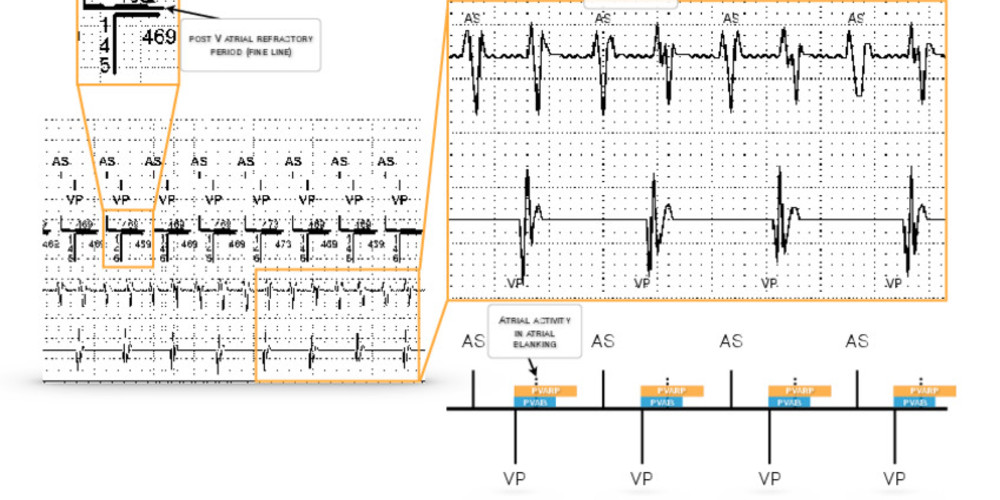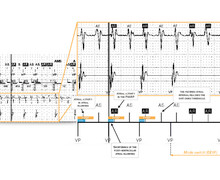post-ventricular atrial blanking and 2:1 flutter
Tracing
Manufacturer Abbott
Device PM
Field AV delays, refractory periods management of tachycardia
N° 26
Patient
61-year-old man implanted with an AccentTM DR dual-chamber pacemaker for complete atrioventricular block; consults for palpitations; during interrogation of the pacemaker, evidence of tachycardia.

Graph and trace
The atrial EGM reveals the presence of atrial tachycardia (flutter) with regular, monomorphic atrial cycles (true intervals 235 ms); one out of every two signals is sensed by the atrial channel, the second signal falling within the post-ventricular atrial blanking (bold line); rapid ventricular pacing at 130 beats/minute, one out of two atrial cycles being classified as AS and thus triggering an AV delay; absence of fallback.

Other articles that may be of interest to you





This tracing shows the limitations of the programming of an overly prolonged post-ventricular atrial blanking period. Failure to sense one out of two atrial signals during a flutter episode leads to the occurrence of poorly-tolerated paced tachycardia in this pacemaker-dependent patient. Reducing its value allows the diagnosis of atrial arrhythmia and rapid mode switching. To avoid crosstalk while maintaining the ability to properly sense atrial arrhythmias, the programming can teeter on a balance between blanking periods and atrial sensitivity.
Post-ventricular atrial blanking (PVAB) is an absolute refractory period applied in the atrium after ventricular sensing and pacing. Its duration can be viewed on the tracing by a bold line following ventricular pacing. Its purpose is to avoid the sensing of the ventricular pacing artifact and the depolarization of the intrinsic or paced ventricle by the atrial channel. The atrial events occurring during this absolute refractory period are not sensed and are therefore not taken into account for the counting of atrial arrhythmias (calculation of the filtered atrial rate). The duration of the atrial blanking is programmable between 60 to 250 ms with a nominal value of 150 ms.
The post-ventricular atrial refractory period (PVARP) is a relative refractory period that follows the PVAB. Its main function is to prevent the occurrence of pacemaker-mediated tachycardia by classifying retrograde atrial conduction as refractory (AR on the marker chain). To avoid recycling ventricular pacing due to retrograde atrial conduction, the PVARP must theoretically be programmed to a value greater than the patient's retrograde ventriculoatrial conduction time. The mean value of the retrograde conduction time is between 220 and 280 ms depending on the patients, although can sometimes be even longer with the need to extend the PVARP. A PVARP programmed too long can, however, induce the appearance of a 2:1 block during exercise at quite low intrinsic rates when the pacemaker is functioning in atrial tracking mode (DDD or VDD). The PVARP is programmable between 125 and 475 ms (nominal value 275 ms). The programming of a dynamic PVARP enables adjusting the value of the PVARP according to the heart rate thereby distancing the 2:1 point. This setting can be set to Off, Low, Medium, High. The PVARP is shortened linearly in order to reach a target atrial sensing window which is even more extensive if the parameter is set to High. It is also necessary to program the shortest PVARP (programmable between 125 and 475 ms, nominal value 175 ms).